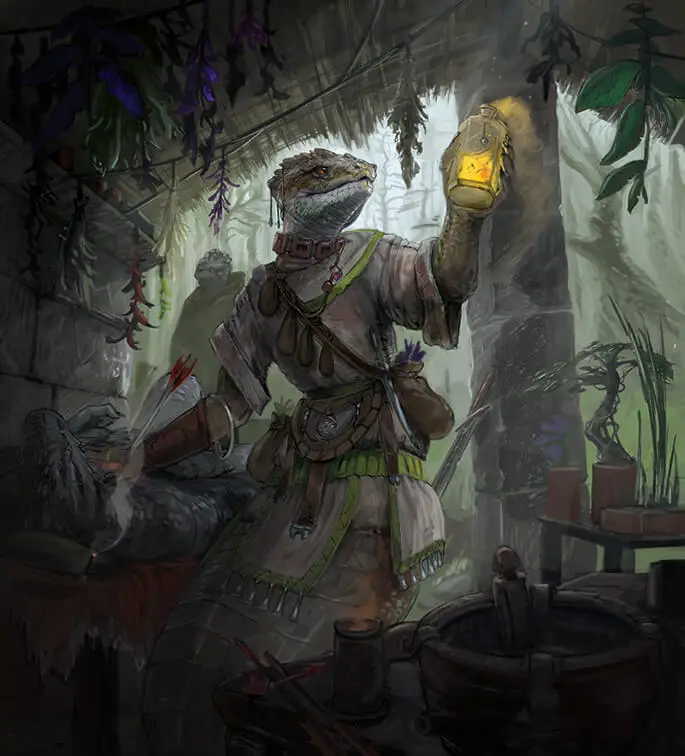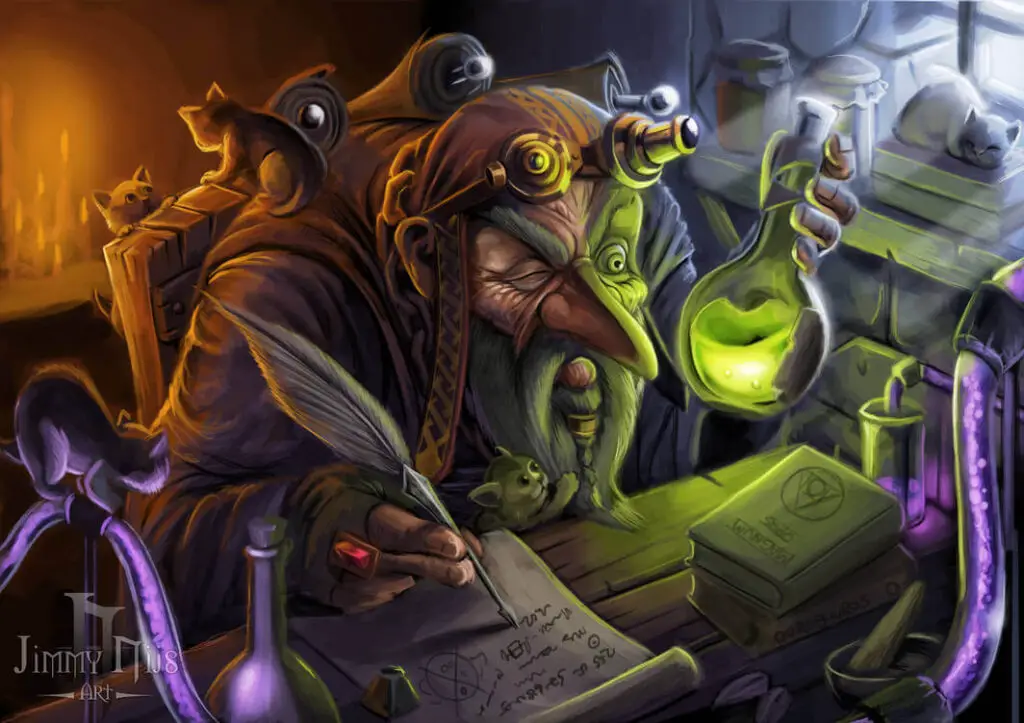D&D 5e Artificer multiclassing image is Warforged Artificer by captdiablo used under Creative Commons Attribution-Noncommercial-No Derivative Works 3.0 License.
This article contains affiliate links that add gold to our coffers.
Welcome to Flutes’ exhaustive guide for Artificer multiclassing character concepts. Multiclassing is daunting for new players but rewarding for experienced players. Many classes benefit more from multiclassing than from investing twenty levels in a single class. Aside from optimization, multiclassing allows you to bring unique characters to life with outside-the-box specialties. Multiclassing can be useful for roleplaying as well, so it’s not merely for min-max-style players.
Some Artificer multiclass concepts involve Artificer as the primary class with the majority of the levels. Other concepts will include the Artificer as a secondary class with the minority of level investment. The secondary class may be referred to as a “dip” if the concept only needs 1-3 levels in the second class. Being a secondary class does not mean a character won’t start at level one as that class; some classes get more armor and hitpoints at level one.
Artificer Multiclassing Quicklinks by Subclass (skip ahead)
Skip ahead to the portion of the article that interests you most by clicking the link below:
— Artificer Multiclassing Principles
— Alchemist
— Armorer
— Artillerist
— Battle Smith
Artificer Multiclassing Rules and Best Practices
Common reasons to multiclass include gaining proficiency with better armor or weapons, learning low-level impactful spells, following a theme, and obtaining damage boosts. The Artificer already has decent proficiencies with light and medium armor, several tools, and shields. The Armorer goes one step further and gets heavy armor. Still, other Artificer subclasses may be incentivized to start as Fighters or other classes that have heavy armor proficiency at level one.
If your character didn’t begin as an Artificer at level one, they gain several proficiencies when they dip into Artificer. Dipping one level of Artificer unlocks proficiency with light and medium armor, shields, thieves’ tools, and tinker’s tools. For spell slot progression, you’ll follow the rules with the Artificer counting as a half-caster. You’ll learn several spells, including cantrips.
One reason to start at level one as an Artificer is to secure proficiency with Constitution and Intelligence saving throws. These are important for your concentration maintenance, but it’s also one of the three common saving throws. Proficiency with Intelligence saving throws is less important, though there are more spells now that use Intelligence saves.
If you’re brand new to multiclassing, I recommend reading our multiclassing combinations article for an overview of each class and how it multiclasses well or poorly. You can also read up on the basics of multiclassing here.
Don’t forget that multiclassing requires minimum ability scores in both new and prior classes (described on PHB p.163, or TCoE for Artificers). For example, if you are an Artificer multiclassing as a Rogue, you’ll need an Intelligence score of 13 or higher and a Dexterity score of 13 or higher.
Class Ability Score Requirements
- Artificer – Intelligence 13
- Barbarian – Strength 13
- Bard – Charisma 13
- Cleric – Wisdom 13
- Druid – Wisdom 13
- Fighter – Strength 13 or Dexterity 13
- Monk – Dexterity 13 and Wisdom 13
- Paladin – Strength 13 and Charisma 13
- Ranger – Dexterity 13 and Wisdom 13
- Rogue – Dexterity 13
- Sorcerer – Charisma 13
- Warlock – Charisma 13
- Wizard – Intelligence 13
Not all level-twenty abilities are worth getting; for example, Rangers have a poor level-twenty class feature, so they gain more from multiclassing. Other classes like Druid and Paladin have excellent level-twenty abilities. I typically shy away from recommending multiclass if they’re a character’s core class. The exception would be if I have a fun concept or focus on lower levels of play; after all, most campaigns end by level ten. Several of my recommendations are thematically cool or unusually unique to D&D.
Dipping 1-2 Levels to/from Artificer
As mentioned earlier, dipping one or two levels can be enough to justify multiclassing. Let’s review which combinations get enough value from dipping and don’t require extensive multiclassing.
Which classes have the best reasons to dip into Artificer?
Wizards were the solo Intelligence-based class until the Artificer arrived. Since these classes’ multiclassing requirements are based on Intelligence, it’s an easy dip for Wizard characters. Wizards gain much from one level of Artificer, particularly proficiency with medium armor and shields. If you start the game at level one as an Artificer, the character gets Constitution saving throw proficiency to help with spell concentration. Wizards love to concentrate on spells, so having roots in the Artificer kit is helpful. Additionally, one level of Artificer grants many useful spells, including Cure Wounds to transform a Wizard into a part-time healer.
Rogues may also enjoy a one-level dip into Artificer, especially Arcane Tricksters who’ve invested in Intelligence. They gain medium armor and shields, which can increase AC by at least +2 with a shield. Rogues only need one attack per round, so grabbing a cantrip like Booming Blade or Green-Flame Blade will boost their damage output each round while scaling at higher levels. This mainly benefits melee-focused Rogues, but even a ranged attacker can benefit from melee options up their sleeve and bolstered defenses.
Which classes do Artificers want for multiclass dips?
Battle Smiths might benefit from starting with one level of Fighter. The subclass is already battle-ready, and the Fighter’s heavy armor proficiency can bolster its defenses. The alternative would be to invest in Dexterity instead of Strength and stick with medium armor. Action Surge is mighty tempting.
Wizard dips will give a character the best ritual casting in the game and a greater pool of low-level spells to select. Getting a Wizard subclass at level two instead of three is also important because you can quickly gain powerful subclass features. Examples of Wizard subclasses with quality subclass features at level two include Order of Scribes, Divination, War Magic, and Bladesinger Wizards.
How to Roleplay an Artificer Multiclassing
Artificers may be the easiest to flavor for multiclassing. Treat any multiclassing as new or upgraded technology. Even multiclassing with martial classes like Fighters can be described as the Artificer augmenting their own body with magic and tech. You can become the mascot for transhumanism (or whatever lineage your character is).
When you become an Artificer from another class, I recommend leading up to the multiclassing by having your character interested in tinkering and other tools beforehand. You don’t have to do this, but it might make the shift feel more natural for you and your group.
Most players don’t foreshadow or roleplay their core class features anyway, so why should it be so difficult to justify what you gain from multiclassing? Just because you’re not sticking with a single class doesn’t mean you should feel more excessively burdened than other characters to narrate your character’s progress. You could treat the multiclassing as a mere mechanical change. You don’t have to tell people that you’re two classes suddenly. Pretend your core class has something different about it that is justified by multiclassing.
Artificer Multiclass Recommendations by Subclass
Continuing onward, you’ll find my ideas for thematically rich, mechanically strong, or charmingly goofy multiclass concepts for Artificers. If you want to know which classes would do well to dip one or two levels of Artificer, you can reference my general notes earlier in this article for that information.
Feel free to comment with questions about how I’d go about building a particular character concept if you’re interested in it. I won’t do a full write-up like other writers who enjoy describing each detail of a character build, but I’ll happily steer you in the right direction.
Each Artificer subclass receives Specialist spells that would not normally be available to Artificers. For example, the Alchemist can excel in a support role since it learns Healing Word.
Alchemist Artificer Subclass (TCoE)

Bonus proficiencies: Alchemist’s Supplies (or other artisan’s tools if redundant)
Bonus spells:
- Healing Word, Ray of Sickness
- Flaming Sphere, Melf’s Acid Arrow
- Gaseous Form, Mass Healing Word
- Blight, Death Ward
- Cloudkill, Raise Dead
Summary of subclass features: Create Experimental Elixirs for healing, flight, AC, body morphing, speed, and 1d4 boosts. Deal bonus necrotic, acid, fire, or poison damage from spells or enhance healing spells. Experimental Elixirs later can cleanse maladies and grant temporary hitpoints. Finally, gain resistance to acid and poison damage, immunity to the poisoned condition, and cast specific high-level healing spells once without a spell slot per long rest.
Alchemist Artificer Multiclass Recommendations
Life Cleric (1) / Alchemist Artificer (19)
This Alchemist is a healer. One level of Life Cleric gives Bonus Proficiency for heavy armor, first-level Cleric spells and cantrips, and a boost to healing spells with Disciple of Life. This will stack with the Alchemist’s Alchemical Savant feature. The flat bonus to a healing spell will be at least +8 if your Intelligence is 20. It’s not a crazy combo or the best healer in the game, but it’s a boost to your Alchemist if you want to focus on healing and defense. The Cleric spell list is excellent and will prove useful without requiring more than a thirteen in Wisdom for multiclassing requirements.
Since Disciple of Life stacks with Goodberry, consider taking one level of Druid. I’d only consider this if the DM would allow me to still use metal heavy armor (Druids aren’t supposed to). I like the heavy armor defensive boost from the one level of Cleric, so I don’t want to sacrifice that. Goodberry is really good, though. Druid spells will be helpful if you go this route.
Thief Rogue (5) / Alchemist Artificer (15)
I love the Thief Rogue’s Fast Hands ability. With this combination, I picture using Fast Hands to douse someone in oil as a bonus action, followed by casting Heat Metal or another fire spell that deals extra damage from the oil. Alchemists like fire damage! In addition to the subclass benefits, five levels of Rogue can net you some useful tools. You can switch up the level distribution depending on what you want.
Alchemist Artificer (14) / Order of Scribes Wizard (6)
(Inspiration Source) I like this combination because it allows the Alchemist to take advantage of its damage boosts from Alchemical Savant by morphing spells to different damage types. This fits well with my mad scientist concepts from my Artificier feats article. You can also create heaps of spell scrolls with this combination! Alter this combination to a 10/10 level split between the two classes to stack Master Scrivener and Magic Item Adept for swift spell scroll crafting.
You can read more about the Order of Scribes Wizard in this other article.

Alchemist Artificer (3) / Transmutation Wizard (17)
You’re the quintessential experimenter of potions and concoctions. The Alchemist at level three gains Healing Word. You’ll also access Cure Wounds, making you a useful healer for your party. The Artificer’s armor and shield proficiencies are useful for defending yourself. Infusions will allow you to make an Alchemy Jug and/or Bag of Holding for your experimental supplies. This Transmuter will finally have proficiency with Alchemist’s Supplies, too. I kept the Transmutation Wizard levels at seventeen to obtain ninth-level spells.
You will enjoy the Experimental Elixir feature. This special elixir can heal, buff, and transform an ally for a time. A minor flight effect is included in the possible elixir effects. You can also pick interesting cantrips like Guidance and Spare the Dying that would normally be inaccessible to a Wizard. This combination will make the Transmuter far more interesting to play.
By the way, I recommend reading my revised version of the Transmutation Wizard. Feedback from the community has made me confident that it’s a superior version of the lackluster subclass.
Alchemist Artificer (18) / Knowledge Cleric (2)
You’re a genius who hides how much they look to higher powers for temporary knowledge. You can summon knowledge of any tool to gain proficiency for a while! That’s about it. This is a skill/tool-monk build.
Alchemist Artificer (3) / Peace Cleric (17)
Create potions that grant 1d4, cast Bless to grant 1d4, and use your bond for another 1d4. You’re giving allies 3d4 to many of their rolls!
Armorer Artificer Subclass (TCoE)

Bonus proficiencies: Heavy Armor, Smith’s Tools (or other artisan’s tools if redundant)
Bonus spells:
- Magic Missile, Thunderwave
- MIrror Image, Shatter
- Hypnotic Pattern, Lightning Bolt
- Fire Shield, Greater Invisibility
- Passwall, Wall of Force
Summary of subclass features: Use heavy armor without needing Strength to wear it effectively. Switch between melee or ranged specialties and abilities with your armor “Iron Man armor.” Gain Extra Attack, infuse your armor with multiple Infusions instead of one, and later enhance your armor’s specialties.
Armorer Artificer Multiclass Recommendations
Armorer Artificer (3) / Abjuration Wizard (17)
Unlike the Artillerist/Abjuror suggestion above, you’re focusing less on temporary hitpoints. The Armorer allows the character to ignore Strength requirements for heavy armor. It also gives you proficiency with heavy armor. Your Abjuration Wizard will become a juggernaut of arcane metal. Equip a shield, too.
Losing a limb won’t slow you down because your armor functions as a prosthetic arm or leg. Your enhanced armor will provide various benefits, including temporary hitpoints to gain as a bonus action. Remember, temporary hitpoints pair well with your Arcane Ward’s hitpoints. Both work to protect you! Choosing the Heavy Armor Master feat will take your durability to the next level as it reduces incoming weapon damage. Infuse your armor for another +1 bonus to AC. Further, augment your Armor Class with the Warforged race. You’ll be an arcane Terminator, and John Connor is your target Wizard.
Armorer Artificer (3) / Chronurgy Wizard (17)
I’m picturing Kang the Conqueror, a Marvel villain from the future. He possesses expensive Apple/Microsoft hybrid tech that he uses to take over the world. The Armorer will allow you to ignore the Strength requirement of heavy armor (which it’s proficient with). You can describe your armor as possessing aberrant technology that allows you to manipulate time and space. Arcane Abeyance can be described as if your armor is an arcane vending machine as you create the mote (think of it like a jawbreaker). I also picture Syndrome’s Energy Prison tech when I imagine the Momentary Stasis ability activating from your armored wrist.
You can also level this character with an Artificer focus for fifteen levels. The Artificer levels will allow you to reach AC above thirty after magic items and infusions combined with spells like Shield.
Armorer Artificer (3) / Illusion Wizard (17)
Picture Mysterio for this concept. This Illusionist will sport heavy armor since the Armorer removes the Strength requirement to wear heavy armor models. Your armor will usually be the Infiltrator model to enhance your Stealth rolls to hide when you cast Invisibility. Your character can be described as utilizing magical illusion technology in the armor. The armor’s Defensive Field can be used when you’re not stealthy, and it can be described as a blur effect that gives you temporary hitpoints as it slightly redirects incoming attacks.
Armorer Artificer (3) / Necromancy Wizard (17)
This is the concept I’d use if I wanted to be a life-sucking Necromancer. I adore the idea of Grim Harvest working with Vampiric Touch to restore heaps of hitpoints to the Necromancer. Still, the problem is that Necromancer Wizards aren’t durable to run into battle. Grim Harvest also doesn’t help if you’re losing hitpoints faster than you’re healing. That’s where the Artificer comes in. Sharing the need for Intelligence between both classes is a huge benefit. Armorer Artificers gain proficiency with heavy armor, allowing you to properly defend yourself while you’re using Vampiric Touch to sap the lifeforce of your enemies. You won’t spread your stats thin either since Armorers ignore Strength requirements for heavy armor. Charge into battle like the wannabe vampire you are!
Use infusions to augment your armored defenses and life-stealing attacks. Enhanced Arcane Focus infusion gives your Vampiric Touch spell attacks +1 to damage and attack rolls. The Enhanced Defense infusion boosts your AC with +1. You can learn Cure Wounds for basic healing utility. Learn spells like Soul Cage so you can properly declare, “Your soul is mine!” If you include transformative magic like Alter Self in your spellbook, you can play as Shang Tsung with this soul-stealing concept.
Armorer Artificer (3) / War Magic Wizard (17)
I’m starting to think I should’ve named this article “Why Wizards Should Multiclass as Artificers.” This is a remix of my similar recommendation for the Abjuration Wizard. Your durability increases as your AC goes from low teens to high teens. Arcane Deflection will boost your defenses further. You may also access spells that Wizards couldn’t normally learn. Casting Cure Wounds as a Wizard is awesome. The Wizard is already hyper-versatile, and healing options will broaden what you can accomplish.
Battlerager Barbarian (4) / Armorer Artificer (16)
As a genius Artificer, your Battlerager armor has been modified with Infusions to become even more powerful. You could also go for six levels in Barbarian if you want the temporary hitpoints ability of the Battlerager. You’ll be able to make three attacks per turn and eventually pull enemies closer to attack them as a reaction. Since most people have compared the Armorer to Ironman, this is like the Hulkbuster armor!
Eloquence Bard (6) / Scout Rogue (6) / Armorer Artificer (6) / Knowledge Cleric (2)
This is another skill-monkey build! I chose Armorer for the Artificer levels to gain proficiency with heavy armor.
Psi Warrior Fighter (3) / Armorer Artificer (17)
I love mixing with the Psi Warrior because its theme is compatible with many concepts. This concept reminds me of Kang the Conqueror from Marvel comics because he always seemed to have force fields and powerful armor.
Artillerist Artificer Subclass (TCoE)

Bonus proficiencies: Wood Carver’s Tools (or other artisan’s tools if redundant)
Bonus spells:
- Shield, Thunderwave
- Scorching Ray, Shatter
- Fireball, Wind Wall
- Ice Storm, Wall of Fire
- Cone of Cold, Wall of Force
Summary of subclass features: Create cannons/turrets that blast and protect. Use wands and similar items as if they’re firearms and use them more effectively. Later, your cannons become more impactful.
Artillerist Artificer Multiclass Recommendations
Artillerist Artificer (3) / Abjuration Wizard (17)
Suit up in medium armor and a shield. Use your Eldritch Cannon to supply allies and yourself with temporary hitpoints constantly. Your Arcane Ward will also be blocking damage for the party. Artificer Infusions will give you unique enchantments for your armor and other items to enhance your battle effectiveness. This character can be a steam-punk wizard hunter, using magic for hunting magical deviants. With this character, you’ll be countering spells and reducing damage like crazy, and your allies will praise you for it.
Creation Bard (3-6) / Artillerist Artificer (14-17)
This is a “Gunner” character who can create its own gunpowder for firearms and explosives. I recommend asking if your DM will allow your Artillerist Artificer to automatically possess proficiency with firearms; otherwise, select the Gunner feat ASAP. The Creation Bard levels ensure a steady, cheap supply of gunpowder. I’m referencing the DMG p.268 for pricing and mechanics for firearms, gunpowder, and more. Thank you to reader Scott for this multiclass concept!
Rogue Swashbuckler (10) / Artificer Artillerist (10)
This invention is appropriately named the “Swashgunner” by Opal in her seafaring article.
Realistically, we tend to argue that a player should only take one to three secondary class levels to gain armor and skill proficiencies, with maybe a few top-class features. However, sometimes it is exceptionally more fun to build a multiclass for the gimmick and utility. This is one of those builds.
Start as a Rogue Swashbuckler for an initial four skills and weapon proficiencies that indulge Sneak Attack. With the Artificer multiclass, this build focuses less on spellcasting and more on accentuating the Swashbuckler abilities through buffs, utility spells, and an arcane cannon.
At level 9, Artificers can cast Water Walk, even as a ritual, which would preserve their spell slot. Take the battle away from your precious ship, or sabotage the vessels of your enemies stealthily. Combine this with damage from one’s own personal cannon on-board, and you’ve got yourself a savvy, tinkering (and repairing!) pirate with unexpected utility.
With skills in woodcarver’s and other artisan tools, the Artificer addition brings a myriad of magic items (of which you can attune to four and craft in a quarter the time and half the cost) and powerful complimentary infusions. See our articles on crafting magic items for more inspiration.
To really milk this multiclass, a player should focus on high Dexterity and Charisma, even though Artificers shine with Intelligence. Be more of a Swashbuckler in heart than a tinkerer.
Battle Smith Artificer Subclass (TCoE)

Bonus proficiencies: Martial Weapons, Smith’s Tools (or other artisan’s tools if redundant)
Bonus spells:
- Heroism, Shield
- Branding Smite, Warding Bond
- Aura of Vitality, Conjure Barrage
- Aura of Purity, Fire Shield
- Banishing Smite, Mass Cure Wounds
Summary of subclass features: Use martial weapons with your Intelligence score. Create a level-scaling Steel Defender construct pet who aids you in combat. You get Extra Attack and can jolt people with your attacks. Your jolts and Steel Defender become more impactful at higher levels.
Battle Smith Artificer Multiclass Recommendations
Battlesmith Artificer (3) / Bladesinging Wizard (17)
The Battlesmith at level three with Battle Ready can attack with the Intelligence modifier instead of Strength or Dexterity when wielding a magic weapon. This three-level dip in Artificer will allow a Bladesinger to focus on Intelligence over Dexterity. You can flavor this concept as a tinkerer who unlocks their innate combat potential when wielding a magical weapon, harnessing the magical energies to enter something like a battle trance. Fueled by magical energy, this Wizard is a force to be reckoned with. This theme can be explored further with spells like Tenser’s Transformation at high levels of play. Thanks to Ahmed for pointing out this combination.

Battlesmith Artificer (18) / Divination Wizard (2)
Grab the Portent feature and early Wizard spells to boost your teamwork and versatility. You’re focused on being a Battlesmith, but it’s easy to grab two levels of Wizard.
Battlesmith Artificer (18) / War Magic Wizard (2)
War Magic’s Tactical Wit and Arcane Deflection features are never bad. They synergize well with the Artificer’s Int-based abilities, particularly the Battlesmith, who focuses on Intelligence for attacks with magic weapons. It’s important to act early in the initiative order of combat with Tactical Wit. Arcane Deflection has no limit to how many times it can be used, and +4 to a saving throw is always good.
Battlesmith Artificer (18) / Forge Cleric (2)
One level of Forge Cleric gets you heavy armor proficiency and Blessing of the Forge (works like an extra Infusion); take two levels for Channel Divinity: Artisan’s Blessing to fit with your Artificer’s crafting theme and gain a spell slot. This enables your Battlesmith to quickly boost defenses with a single multiclass level (you can skip the second level of the Channel Divinity isn’t interesting to you). You might enjoy casting Searing Smite, though it’s not the best smite spell. Some of your better first-level spell options from the Cleric list are Bless, Shield of Faith, Healing Word, and Protection from Evil and Good.
Psi Warrior Fighter (3) / Battle Smith Artificer (17)
This is similar to my earlier concept for the Armorer, but it’s just as compatible with the Battle Smith. The flavor is less about powerful force-field-producing armor, but you empower your weapons and protect your allies with magical force.
Conclusion
The Artificer class is versatile and possesses features that can transform character concepts. Focusing on Intelligence is a welcome change to D&D 5e since it previously had few reasons to focus on Intelligence. Multiclassing with an Artificer can be quick with one level or three levels for a subclass. I’m glad it isn’t another class that gets its features at first level for obscene multiclassing value.
What is your favorite multiclassing concept for an Artificer? Tell me about it, and I might add it to this article to help other players look for fun concepts.
Y You can find more content on multiclassing in our other articles, particularly our class-level multiclassing combinations article.





The battlesmith/bladesinger combination really works best with a tortle. Otherwise you can’t really afford to ignore Dex without having a problem with your AC.
That’s an important consideration, Rivenstone! Grabbing points in Dex while using Mage Armor and the Shield spell will be helpful for defense.
I’m flirting with the idea of rogue inquisitive 5-3/ _____________ artificer 15 – 17. I had battlesmith in mind because of the INT modifier to weapon attacks combining with sneak attacks and pistol (Lantanese Naval background). However, my group wanted me to have access to fireball so artillerist won out.
That said, the final intent falls somewhere around RDJ’s Sherlock. The inquisitive has a load of observation based benefits at 3rd level that stack well with the Observation feat and Expertise. Crossbow Expertise if only to lose disadvantage in melee while using a ranged weapon. Fighting style: Archery feat too.
Darn you fireball spell. I would’ve had a steampunk Dr. Watson at my side with the Steel Defender too.
That’s really nice of you to go for Fireball at the party’s request. Being a half-caster means you get it later, so I hope it’s still useful by then! 🙂
And I like the Sherlock intent with heaps of bonuses for observation-based skills.
This post made me realize that my multclass choice isn’t the best, but no matter, I really want to become an artificer bard who uses the craziest trinkets to create music and art. I just hope to survive until I reach my goal XD
It may not be the most powerful option, but I’m sure you’ll enjoy it! 🙂 Combining the inventive nature of the Artificer with the artistic nature of the Bard sounds really fun. If you don’t want to multiclass for mechanical reasons, you could choose to be an artistic Artificer, no problem.
Thanks for your work, you have great articles
Thank you! We’ll keep it up. 🙂
Fantastic multiclasses! The first Artificer dip I ever did (and first character I ever played) was a Scout Rogue 4/Artificer 1 Tabaxi. They were an alchemist by trade, willing to explore and find the items needed for their alchemical endeavors. Sadly, the game ended before I could unlock the subclass. Probably would have been a 10/10 split, if the game would’ve gone to level 20. Will have to go back to this character one day!
Also, I played a Gloom Stalker Ranger 5/Artillerist Artificer 15 Wildhunt Shifter last year. We were military (me being a support sniper), so many of my spells were special ammo for my high-tech rifle or tech I “developed”. The Eldritch Cannon was styled as an energy side-arm, high-powered wrist flamethrower, or a minor AoE force field, depending. Arcane Firearm was just crafted into my weapon. Would only recommend if you roll extremely well. Heh
I think a Psi Warrior/Artillerist can have a nice synergy knocking people away and not needing Wisdom, if someone wanted to go that route.
Those are fantastic concepts! There’s something about the Psi Warrior Fighter that makes me want to play it (even though I’ve yet to hear of someone playing it haha). I’d be interested in a Psi Warrior/Artificer.
what about an artificer/druid build, like battlesmith/wildfire?
I don’t know of synergy between the two, at least not off the top of my head. Maybe the wildfire spirit is flavored as a spirit of the forge for a narrative synergy.
Imagine you’re a Warforged. You’re a created thing. And you’re an Artificer, a creator of things. Not uncommon, of course, but this is important. You’re also a Battle Smith, so you have your Steel Defender, which is bipedal/humanoid, and you’ve created it to look… like you! Minus some of your gear, of course. So there’s you, and your “pet” which looks like you. Now, imagine…. you multiclass into Echo Knight. You can bring into this world an alt-universe version of yourself! And he’s a Battle Smith with his own Steel Defender that looks like him! Now there are two of you, and two Steel Defenders which look like you. Appearing as if there are four of you on the battle map! You can swap places with your echo, and (presumably) your pet can swap with your echo’s pet. Positioning all four of yourselves, you generate advantage against multiple foes. I give you…. Reginald the Several!
That character name XD lol